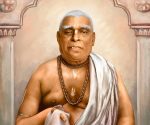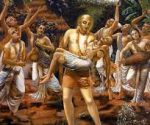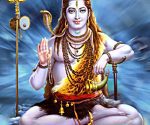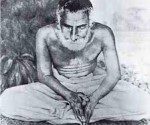Sri Locana Das Thakur
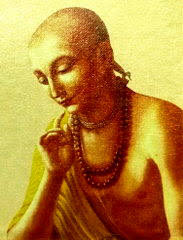 by Srila Bhakti Ballabh Tirtha Maharaja
by Srila Bhakti Ballabh Tirtha Maharaja
[On the holy occasion of the appearance day of Sri Locanan Dasa Thakura ( 3 Jan 2003), The following is an excerpt from the book “Sri Chaitanya: His Life and Associates” by Srila Bhakti Ballabh Tirtha Maharaj.]
Family life
Locana Das Thakur was born in 1523 in Kograma, in the Katwa block of Burdwan district. This village is about ten miles north of Guskara train station. The Thakur’s home is situated near the Ajaya River.
His birth tithi is given by some as the first day of the fortnight of the waxing moon in Paush. He was born in the Raṛhīya clan of the physician caste (vaidya). His father’s name was Kamalakara Das, his mother’s Sadanandé. Locana Das studied at his maternal grandfather’s house. He displayed devotion for Mahaprabhu from his childhood.
Locana Das was married at a very young age, according to the customs of that epoque. His in-laws’ household was in the village of Amedpura Kakuöa. However, though he had entered the married station, he was extremely renounced and spent all his time discussing Krishna-katha with other devotees of Gauranga.
Since Locana Das was married at a very early age, his wife at first remained with her parents, but as the time approached when she was to join him, they began to worry because of Locana Das’s indifference to material life. They approached his guru Narahari Sarkara and told him of their disquiet. As a result, Narahari ordered Locana Das to go to his in-laws’ home.
When Locana arrived in their village he was unable to remember where their house was, since it had been so long since he had visited. He asked a young girl in the street for directions, addressing her as “Ma”, or “mother”. When he arrived at his in-laws’ house, he learned that the girl whom he had addressed as his mother was in fact his wife. From that day on, he always looked upon his wife as a mother, worshiping Guru and Gauranga in an attitude of renunciation.
The Chaitanya Mangala
Narahari Sarakara Thakur, Mahaprabhu’s famous associate from Śrīkhaṇḍa, was very affectionate to Locana Das and gave him initiation. Locana Das enthusiastically took up residence with his guru in Śrīkhaṇḍa. His guru taught him the art of kirtan and later ordered him to write Mahaprabhu’s sacred biography. Locana Das took this order seriously and wrote the Chaitanya Mangala, the events of which are based on Murari Gupta’s Chaitanya-carita.
The word mangala means auspicious and this title reflects the fact that hearing Mahaprabhu Sri Chaitanya’s divine pastimes is the most auspicious activity for all the living beings. Vrindavan Das Thakur’s biography of the Lord was first named Chaitanya Mangala and was only later known as Chaitanya Bhagavat. Locana Das gives an indication of this in the introductory portion of his book:
I attentively pay my obeisances to Vrindavan Das Thakur; his Bhagavat’s songs have enchanted the entire universe. (CM Sutrakhanda, 1.35)
Some people believe that Locana Das and Krishnadas Kaviraj Goswami gave the name Chaitanya Bhagavat to Vrindavan Das’s book. In the Chaitanya Mangala, Locana Das prays for his guru’s blessings as follows:
Narahari Das Thakur is the proprietor of my life, and out of the hope of attaining his lotus feet, I desire to sing the glories of Gauranga, even though I am the lowest of the low. This is my ambition. (CM Sutrakhanda, 1.9)
I offer my reverences to Narahari Das, the ocean of Gauranga’s qualities. Other than him, I have no friend in the three worlds. (Ibid., 1.33)
My lord and master is Narahari Das. I prostrate myself in humility to him. May he fulfill my desires. (Ibid., 1.61)
Locana Das wrote the Chaitanya Mangala in Eastern Bengal’s Païcalé style, completing it in in 1537 AD. There is a legend that he wrote the book while sitting on a stone under a flower tree. In his new Bengali dictionary, Ashutosh Deb has underlined Locana Das’s contribution by stating that he was the first to write Bengali poetry using moric metres as well as being one of the first historical writers in Bengali. The original manuscript of the Chaitanya Mangala is said to be found in the personal library of Praëakåsëa Chakravarti of Kandaåa near the the Guskara train station.
Other titles attributed to Locana Dâsa are Prarthana, Durlabha-sara, Dhamalé, and Bengali verse translations of Ramananda’s Jagannath-vallabha-naöaka and the Rasa-païcadhyaya.
According to the Bhakti-ratnakara, Locana Das was present at Narahari Sarakara Thakur’s disappearance festival and greeted guests by giving them sandalwood and garlands.
Locana Das’s songs glorifying Nityananda
In the Chaitanya Mangala, Locana Das describes his guru Narahari as being Mahaprabhu’s dearest associate. He does not describe Nityananda’s glories as extensively. Fearful that the neglect of Nityananda might be taken as offensive to his feet, he later wrote a few songs in his praise. These songs are particularly well appreciated by the devotees.
(1)
nitai gunamani amara nitai gunamani
aniya premera banya bhasala abanipremera banya laiya nitai aila gauda-deze
dubila bhakata-gana dina hina bhasedina-hina-patita-pamara nahi bache
brahmara durlabha prema sabakare jaceabaddha karuna-sindhu (nitai) katiya muhana
ghare ghare bule prema amiyara banalocana bole mora nitai jeba na bhajila
janiya zuniya sei atma-ghati haila
Nitai is the jewel of virtue, my Nitai is the jewel of virtue. He brought the deluge of love of God and flooded the world.
He brought the deluge of love of God to Gauòadeça, flooding the devotees. The lowly and deprived are also floating.
He excluded not the lowly and deprived, nor the sinful and atheistic, but insisted that everyone take the gift of love which is beyond the reach of even Brahma.
Nitai cut the floodgates which held back the ocean of compassion, and went from door to door to give the nectar of love to everyone.
Locana Das says that anyone who has not worshiped my Nitai has committed suicide in full knowledge.
(2)
akrodha paramananda nityananda ray
abhimana sunya nitai nagare beday
adhama patita jiver dvare dvare giya
hari nama maha -mantra deno bilaiya
jare dekhe tare kohe dante trna dhori ‘
amare kiniya loho bhajo gaura-hari
eto boli ‘nityananda bhume gadi jay
sonara parvata jeno dhulate lotay
heno avatare jar rati na janmilo
locan bole seri papi elo ar gelo
Lord Nityananda is free from anger and the embodiment of supreme joy. He wanders throughout the town without any pride or arrogance.
He knocks on every fallen person’s door and bestows the maha-mantra of the Holy Names on him.
Placing straw between his teeth, he says to everyone he sees, “Worship Gaura Hari and you will purchase me and make me your slave.”
Then he falls to the ground, looking like a golden mountain rolling in the dust.
Whoever lacks faith in such a compassionate incarnation is a sinner who will go as he has come, says Locana Das.
(3)
parama karuna pahun dui jana
nitai gaurachandra
saba avatara, sara shiromani
kevala ananda kanda
bhaja bhaja bhai, chaitanya nitai
sudhrida visvasa kori
vishaya chariya se rase majiya
mukha bolo hari hari
dekho ore bhai, tribhuvane nai
emona doyala data
pashu-pakhi jhure, pashana vidore
shuni yar guna gantha
samsare majiya, rahile pariya
se pade nahilo asha
apana koroma, bhunjaye shamana,
kohoye locana dasa
Nitai and Gauracandra, are the two most compassionate lords. They are the essence of all incarnations, the crest-jewels of the avatars, the source of the unique joy of prema.
O brother! I implore you to worship Gaura-Nitai with firm faith. Give up your attachment to sense gratification and merge into this nectar by chanting the names of Hari.
Look, O brother! There is no benefactor in the three worlds who is as merciful as they. Even birds and animals are fulfilled by hearing their qualities, and stones melt.
Absorbed in the cycle of birth and death, you have fallen by the wayside without any hope for achieving their company. The lord of death will come and make you suffer the results of your activities – so sings Locana Das.
Gaura-nagara doctrine condemned
Followers of certain heterodox groups or apasampradayas say that the Gaura-nagara doctrine is found in the Chaitanya Mangala. This is not true, however. Vrindavan Das Thakur writes in his Chaitanya Bhagavat: gauranga nagara hena stava nahi bale — “No one should praise the Lord by calling him the golden playboy.” Srila Bhaktisiddhanta Saraswati Goswami Thakur comments: “Gaurasundara is Krishna who has been endowed with Radha’s bodily hue and her mood of love. Thus he never abandoned the qualities of the heart of Radha and the other gopis, i.e., the character of the açraya of devotion in the erotic mood. This means that he never acts like the visaya (‘object’) or bhokta (‘enjoyer’) of madhura-rasa by looking at other women in the spirit of a playboy.”
Locana Das ended his pastimes in this world in 1589 AD. A brick samadhi at his çrépaöa marks the place where his remains are buried.
For more articles on a variety of devotional topics by and about Srila Bhakti Ballabh Tirtha Maharaj and other Vaishnava authors, kindly visit the GOKUL website at http://www.gokul.org or http://www.sreecgmath.org For more information, or to subscribe to our newsletter, write to bhakti@gokul.org




